
Hassium is a chemical element with the symbol Hs and the atomic number 108. Hassium is highly radioactive; its most stable known isotopes have half-lives of approximately ten seconds. One of its isotopes, 270Hs, has magic numbers of both protons and neutrons for deformed nuclei, which gives it greater stability against spontaneous fission. Hassium is a superheavy element; it has been produced in a laboratory only in very small quantities by fusing heavy nuclei with lighter ones. Natural occurrences of the element have been hypothesised but never found.
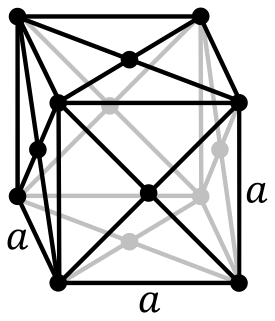
Oganesson is a synthetic chemical element with the symbol Og and atomic number 118. It was first synthesized in 2002 at the Joint Institute for Nuclear Research (JINR) in Dubna, near Moscow, Russia, by a joint team of Russian and American scientists. In December 2015, it was recognized as one of four new elements by the Joint Working Party of the international scientific bodies IUPAC and IUPAP. It was formally named on 28 November 2016. The name is in line with the tradition of honoring a scientist, in this case the nuclear physicist Yuri Oganessian, who played a leading role in the discovery of the heaviest elements in the periodic table. It is one of only two elements named after a person who was alive at the time of naming, the other being seaborgium, and the only element whose namesake is alive today.

Unbinilium, also known as eka-radium or simply element 120, is the hypothetical chemical element in the periodic table with symbol Ubn and atomic number 120. Unbinilium and Ubn are the temporary systematic IUPAC name and symbol, which are used until the element is discovered, confirmed, and a permanent name is decided upon. In the periodic table of the elements, it is expected to be an s-block element, an alkaline earth metal, and the second element in the eighth period. It has attracted attention because of some predictions that it may be in the island of stability, although newer calculations expect the island to actually occur at a slightly lower atomic number, closer to copernicium and flerovium.
Moscovium is a synthetic chemical element with the symbol Mc and atomic number 115. It was first synthesized in 2003 by a joint team of Russian and American scientists at the Joint Institute for Nuclear Research (JINR) in Dubna, Russia. In December 2015, it was recognized as one of four new elements by the Joint Working Party of international scientific bodies IUPAC and IUPAP. On 28 November 2016, it was officially named after the Moscow Oblast, in which the JINR is situated.
Tennessine is a synthetic chemical element with the symbol Ts and atomic number 117. It is the second-heaviest known element and the penultimate element of the 7th period of the periodic table.

A synchrotron is a particular type of cyclic particle accelerator, descended from the cyclotron, in which the accelerating particle beam travels around a fixed closed-loop path. The magnetic field which bends the particle beam into its closed path increases with time during the accelerating process, being synchronized to the increasing kinetic energy of the particles. The synchrotron is one of the first accelerator concepts to enable the construction of large-scale facilities, since bending, beam focusing and acceleration can be separated into different components. The most powerful modern particle accelerators use versions of the synchrotron design. The largest synchrotron-type accelerator, also the largest particle accelerator in the world, is the 27-kilometre-circumference (17 mi) Large Hadron Collider (LHC) near Geneva, Switzerland, built in 2008 by the European Organization for Nuclear Research (CERN). It can accelerate beams of protons to an energy of 6.5 teraelectronvolts (TeV).

The Joint Institute for Nuclear Research, in Dubna, Moscow Oblast, Russia, is an international research center for nuclear sciences, with 5500 staff members, 1200 researchers including 1000 Ph.Ds from eighteen states, members of the institution. Most scientists, however, are eminent Russian scientists.
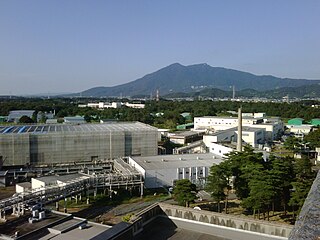
The High Energy Accelerator Research Organization, known as KEK, is a Japanese organization whose purpose is to operate the largest particle physics laboratory in Japan, situated in Tsukuba, Ibaraki prefecture. It was established in 1997. The term "KEK" is also used to refer to the laboratory itself, which employs approximately 695 employees. KEK's main function is to provide the particle accelerators and other infrastructure needed for high-energy physics, material science, structural biology, radiation science, computing science, nuclear transmutation and so on. Numerous experiments have been constructed at KEK by the internal and international collaborations that have made use of them. Makoto Kobayashi, emeritus professor at KEK, is known globally for his work on CP-violation, and was awarded the 2008 Nobel Prize in Physics.

High-energy nuclear physics studies the behavior of nuclear matter in energy regimes typical of high-energy physics. The primary focus of this field is the study of heavy-ion collisions, as compared to lighter atoms in other particle accelerators. At sufficient collision energies, these types of collisions are theorized to produce the quark–gluon plasma. In peripheral nuclear collisions at high energies one expects to obtain information on the electromagnetic production of leptons and mesons that are not accessible in electron–positron colliders due to their much smaller luminosities.
NICA is a particles accelerator complex being constructed by JINR near Moscow, Russia to perform experiments such as Nuclotron ion beams extracted to a fixed target and colliding beams of ions, ions-protons, polarized protons and deuterons. The projected maximal kinetic energy of the accelerated ions is 4.5 GeV, and 12.6 GeV for protons.
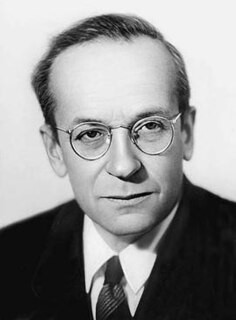
Vladimir Iosifovich Veksler – September 22, 1966 in Moscow, USSR) was a prominent Soviet experimental physicist.

Herwig Franz Schopper, is an experimental physicist and was the Director General of CERN from 1981 to 1988.

Wang Ganchang was a Chinese nuclear physicist. He was one of the founding fathers of Chinese nuclear physics, cosmic rays and particle physics. Wang was also a leader in the fields of detonation physics experiments, anti-electromagnetic pulse technology, nuclear explosion detection, anti-nuclear radiation technology, and laser stimulated nuclear explosion technologies.
Alexander Mikhajlovich Baldin was a Russian Soviet physicist, expert in the field of physics of elementary particles and high energy physics.
Sigurd Hofmann is a physicist known for his work on superheavy elements.
A Fixed-Field alternating gradient Accelerator (FFA) is a circular particle accelerator concept on which development was started in the early 50s, and that can be characterized by its time-independent magnetic fields and the use of strong focusing. Thus, FFA accelerators combine the cyclotron's advantage of continuous, unpulsed operation, with the synchrotron's relatively inexpensive small magnet ring, of narrow bore.

Nuclotron is the world's first superconductive synchrotron, exploited by the Joint Institute for Nuclear Research in Dubna, Russia. This particle accelerator is based on a miniature iron-shaped field superconductive magnets, and has a particle energy up to 7 GeV. It was built in 1987-1992 as a part of Dubna synchrophasotron modernisation program. 5 runs of about 1400 hours total duration have been provided by the present time. The most important experiments tested the cryomagnetic system of a novel type, and obtained data on nuclear collisions using internal target.

Yuri Tsolakovich Oganessian is a Russian nuclear physicist of Armenian descent who is considered the world's leading researcher in superheavy chemical elements. He led the discovery of these elements in the periodic table. He succeeded Georgy Flyorov as director of the Flerov Laboratory of Nuclear Reactions at the Joint Institute for Nuclear Research in 1989 and is now its scientific leader. The heaviest element on the periodic table, oganesson, is named after him, only the second time that an element was named after a living scientist.
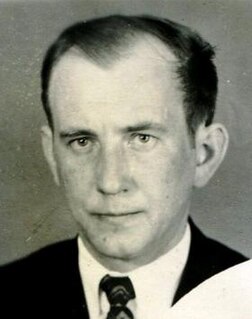
Boris Vladimirovich Struminsky was a Russian and Ukrainian physicist known for his contribution to theoretical elementary particle physics.
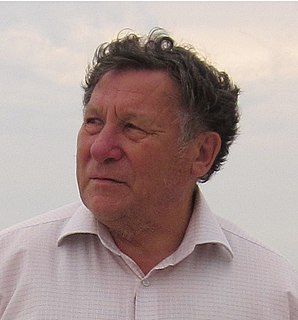
Eduard Alekseevich Kuraev — Soviet and Russian theoretical physicist. Doctor of Physical and Mathematical Sciences (1971).














